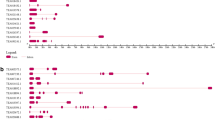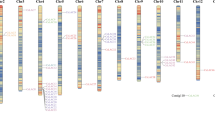Abstract
Of the two commercially cultivated coffee (Coffea) species, C. arabica (arabica) is highly susceptible and C. canephora (robusta) is highly resistant to the insect pest Xylotrechus quadripes (Coleoptera: Cerambycidae), commonly known as coffee white stem borer (CWSB). We constructed a forward-subtracted cDNA library by Suppression Subtractive Hybridization (SSH) from robusta bark tissue for profiling genes induced by CWSB infestation. Among the 265 unigenes of the SSH EST library, 7 unigenes (5 contigs and 2 singletons) matching different pectin-degrading enzymes were discovered. These ESTs matched one pectate lyase, three polygalacturonases, and one pectin acetylesterase gene. Quantitative real-time PCR (qRT-PCR) revealed that CWSB infestation strongly induces the pectate lyase gene at 72 h. Complete cDNA sequence of the pectate lyase gene was obtained through 3′ and 5′ RACE reactions. It was a 1595 bp long sequence that included full CDS and both UTRs. Against C. canephora genome sequences in Coffee Genome Hub database (http://coffee-genome.org/), it had 22 matches to different pectate lyase genes mapped on 9 of the 11 pseudochromosomes, the top match being Cc07_g00190 Pectate lyase. In NCBI database, it matched pectate lyase sequences of several plants. Apart from C. canephora, the closest pectate lyase matches were from Sesamum indicum and Nicotiana tabacum. The pectinolytic enzymes discovered here are thought to play a role in the production of oligogalacturonides (OGs) which act as Damage-Associated Molecular Pattern (DAMP) signals eliciting innate immunity in plants. The pectate lyase gene, induced by CWSB infestation, along with other endogenous pectinolytic enzymes and CWSB-specific elicitors, may be involved in triggering basal defense responses to protect the CWSB-damaged tissue against pathogens, as well as to contain CWSB in robusta.


Similar content being viewed by others
References
Anonymous (2014) Coffee Guide. Central Coffee Research Institute, Chikmagalur
Benedetti M, Pontiggia D, Raggi S, Cheng Z, Scaloni F, Ferrari S, Ausubel FM, Cervone F, De Lorenzo G (2015) Plant immunity triggered by engineered in vivo release of oligogalacturonides, damage-associated molecular patterns. Proc Natl Acad Sci 112(17):5533–5538
Bishop PD, Pearce G, Bryant JE, Ryan CA (1984) Isolation and characterization of the proteinase inhibitor-inducing factor from tomato leaves. Identity and activity of poly- and oligogalacturonide fragments. J Biol Chem 259:13172–13177
Boller T, Felix G (2009) A renaissance of elicitors: perception of microbe-associated molecular patterns and danger signals by pattern-recognition receptors. Annu Rev Plant Biol 60:379–406. doi:10.1146/annurev.arplant.57.032905.105346
Davis AP (2011) Psilanthus mannii, the type species of Psilanthus, transferred to Coffea. Nordic J Botany 29(4):471–472
De Lorenzo G, Brutus A, Savatin DV, Sicilia F, Cervone F (2011) Engineering plant resistance by constructing chimeric receptors that recognize damage-associated molecular patterns (DAMPs). FEBS Lett 585:1521–1528. doi:10.1016/j.febslet.2011.04.043
Delessert C, Wilson IW, Van Der SD, Dennis ES, Dolferus R (2004) Spatial and temporal analysis of the local response to wounding in Arabidopsis leaves. Plant Mol Biol 55:165–181. doi:10.1007/s11103-004-0112-7
Denoux C, Galletti R, Mammarella N, Gopalan S, Werck D, De Lorenzo G, Ferrari S, Ausubel FM, Dewdney J (2008) Activation of defence response pathways by OGs and Flg22 elicitors in Arabidopsis seedlings. Molecular Plant 1(3):423–445
Dereeper A, Bocs S, Rouard M, Guignon V, Ravel S, Tranchant-Dubreuil C, Poncet V, Garsmeur O, Lashermes P, Droc G (2015) The coffee genome hub: a resource for coffee genomes. Nucleic Acids Res 43(D1):D1028–D1035
Diatchenko L, Lau YF, Campbell AP, Chenchik A, Moqadam F, Huang B, Lukyanov S, Lukyanov K, Gurskaya N, Sverdlov ED, Siebert PD (1996) Suppression subtractive hybridization: a method for generating differentially regulated or tissue-specific cDNA probes and libraries. Proc Natl Acad Sci USA 93:6025–6030
Doares SH, Syrovets T, Weiler EW, Ryan CA (1995) Oligogalacturonides and chitosan activate plant defensive genes through the octadecanoid pathway. Proc Natl Acad Sci 92:4095–4098
Duran-Flores D, Heil M (2016) Sources of specificity in plant damaged-self recognition. Curr Opin Plant Biol 32:77–87
Frohman MA, Dush MK, Martin GR (1988) Rapid production of full-length cDNA from rare transcripts: amplification using a single gene-specific oligonucleotide primer. Proc Natl Acad Sci USA 85:8998–9002
Galletti R, Denoux C, Gambetta S, Dewdney J, Ausubel FM, De Lorenzo G et al (2008) The AtrbohD-mediated oxidative burst elicited by oligogalacturonides in Arabidopsis is dispensable for the activation of defence responses effective against Botrytis cinerea. Plant Physiol 148:1695–1706. doi:10.1104/pp.108.127845
Gatehouse JA (2002) Plant resistance towards insect herbivores: a dynamic interaction. New Phytol 156:145–169. doi:10.1046/j.1469-8137.2002.00519.x
International Coffee Organization (ICO): http://www.ico.org
John M, Röhrig H, Schmidt J, Walden R, Schell J (1997) Cell signalling by oligosaccharides. Trends Plant Sci 2(3):111–115
Kumar S, Tamura K, Nei M (1994) MEGA: molecular evolutionary genetics analysis software for microcomputers. CABIOS 10:189–191
Lan CC, Wintgens JN (2004) Major pests of coffee in the Asia–Pacific region. In: Wintgens JN (ed) Coffee: growing, processing, sustainable production. A guide book for growers, processors, traders and researchers. Wiley-VCH. pp 459–473
Livak KJ, Schmittgen TD (2001) Analysis of relative gene expression data using real-time quantitative PCR and the 2 − ΔΔCT method. Methods 25(4):402–408
Moloshok T, Pearce G, Ryan CA (1992) Oligouronide signaling of proteinase inhibitor genes in plants: structure-activity relationships of di-and trigalacturonic acids and their derivatives. Arch Biochem Biophys 294(2):731–734
Reymond P, Weber H, Damond M, Farmer EE (2000) Differential gene expression in response to mechanical wounding and insect feeding in Arabidopsis. Plant Cell 12:707–720. doi:10.1105/tpc.12.5.707
Rhainds M, Lan CC, Zhen ML, Gries G (2002) Incidence, symptoms and intensity of damage by three coffee stem borers (Coleoptera: cerambycidae) in South Yunan, China. J Econ Entomol 95(1):106–112
Santosh P, Sreenath HL (2012) Synthesis of good quality double-stranded cDNA from the bark tissue of robusta coffee (Coffea canephora) plants. Res Biotechnol 3(4):37–41
Santosh P, Sreenath HL, Vinod Kumar PK, Seetharama HG, Jayarama (2011) New record of coffee white stem borer Xylotrechus quadripes Chevrolat on Psilanthus bengalensis in India. J Plantat Crops 39(3):396–398
Savatin DV, Gramegna G, Modesti V, Cervone F (2014) Wounding in the plant tissue: the defense of a dangerous passage. Front Plant Sci 5:470
Seetharama HG, Vasudev V, Vinod Kumar PK, Sreedharan K (2005) Biology of coffee white stem borer Xylotrechus quadripes Chev. (Coleoptera: Cerambycidae). J Coffee Res 33(1–2):98–107
Venkatesha MG, Dinesh AS (2012) The coffee white stemborer Xylotrechus quadripes (Coleoptera: cerambycidae): bioecology, status and management. Int J Trop Insect Sci 32(04):177–188
Author information
Authors and Affiliations
Corresponding author
Ethics declarations
Conflict of interest
The authors declare no conflict of interest.
Rights and permissions
About this article
Cite this article
Bharathi, K., Santosh, P. & Sreenath, H.L. Transcripts of pectin-degrading enzymes and isolation of complete cDNA sequence of a pectate lyase gene induced by coffee white stem borer (Xylotrechus quadripes) in the bark tissue of Coffea canephora (robusta coffee). 3 Biotech 7, 45 (2017). https://doi.org/10.1007/s13205-017-0715-8
Received:
Accepted:
Published:
DOI: https://doi.org/10.1007/s13205-017-0715-8




